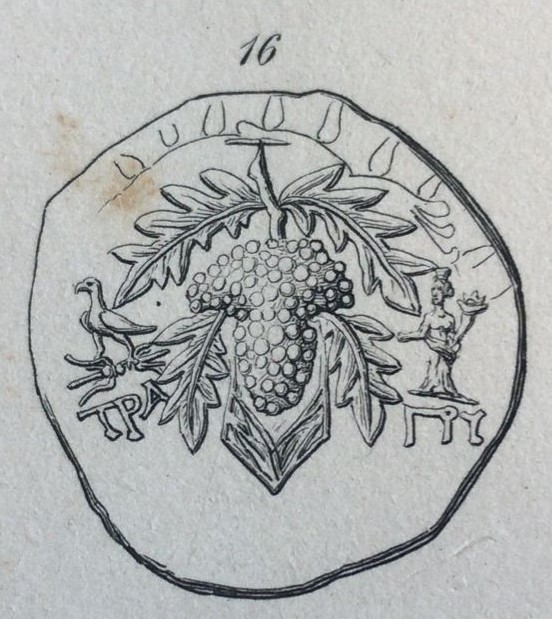130 BCE - 129 BCE | TΡΑ / ΠΥ
Overstriking coin
Tralles_Pinder_drawing.jpg [Pinder 1856, pl. I, n°16]
Description
| ObverseInscription or printing placed on the obverse.:
|
Cista mystica with half-open lid, from which a snake issues to left, all within ivy wreath.
|
ReverseInscription or printing placed on the reverse.:
|
TΡΑ / ΠΥ (Greek) Grape bunch on vine with leaves in background, to left eagle standing left on on thunderbolt, to right Tyche holding cornucopia in her left hand
|
Mint and issuing power
| MintIdentifies the place of manufacture or issue of a numismatic object.:
|
Tralles
|
Ancient regionAncient region.
|
Lydia
|
Modern countryModern country: Turkey
|
AuthorityIdentifies the issuing power. The authority can be "pretended" when the name or the portrait of X is on the coin but he/she was not the issuing power. It can also be "uncertain" when there is no mention of X on the coin but he/she was the issuing power according to the historical sources:
|
|
Chronology
| FromIdentifies the initial date in a range assigned in a numismatic context. 130 BCE toIdentifies the final date in a range assigned in a numismatic context.. 129 BCE
|
Hellenistic 323-30 BC  periodTime period of the numismatic object. periodTime period of the numismatic object.
|
Physical description
MetalThe physical material (usually metal) from which an object is made.: Silver 
|
WeightWeight of the numismatic object (in grams). in grams: 6.26.2 g <br />6,200 mg <br />
|
DenominationTerm indicating the value of a numismatic object. Examples: tetradrachm, chalkous, denarius.: cistophoric didrachm
|
|
|
|
StandardStandard.: cistophoric
|
References
Description
| ObverseInscription or printing placed on the obverse.:
|
Head of Helios facing (visible on the reverse)
|
ReverseInscription or printing placed on the reverse.:
|
Rose.
|
Mint and issuing power
| MintIdentifies the place of manufacture or issue of a numismatic object. ᵖ:
|
Rhodes
|
Ancient regionAncient region. ᵖ
|
Caria (islands)
|
Modern countryModern country: Greece
|
AuthorityIdentifies the authority in whose name (explicitly or implicitly) a numismatic object was issued. ᵖ:
|
|
Chronology
| FromIdentifies the initial date in a range assigned in a numismatic context. 189 BCE toIdentifies the final date in a range assigned in a numismatic context.. 150 BCE
|
Hellenistic 323-30 BC  periodTime period of the numismatic object. periodTime period of the numismatic object.
|
Physical description
| DenominationTerm indicating the value of a numismatic object. Examples: tetradrachm, chalkous, denarius. ᵖ:
|
didrachm 
|
|
|
References
